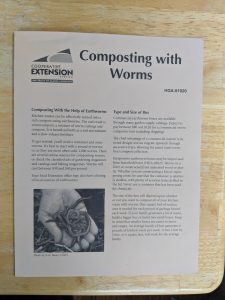Want to see my worms?
This was a common question I’d ask guests visiting my apartment as a vermicompost enthusiast. I was introduced to composting with worms as a young adult living in Chicago, and jumped at the opportunity to make this type of compost a staple of my urban life. I loved that it was an affordable, effective, and relatively effortless way to create nutrients for soil. And the bin fit under my bed.
My vermicompost bin lasted a year and a half. When I moved to Alaska, the bin found itself in my parents’ garage in Illinois where excessive heat killed the worms. I am ready to vermicompost again, and have the resources I need to improve the worms’ home.
Easy to understand guidance

Composting with Worms, published by the University of Alaska Fairbanks Cooperative Extension, is a helpful resource for those delving into vermicomposting. The publication features crucial information that is updated every few years: what vermicomposting is, required material, number and kind(s) of worm, how to maintain a vermicompost, problems you may run into, how to avoid them, and how to troubleshoot. I always appreciate frequently asked questions, which this publication provides. I did not have this information when I first began composting, and could have benefited from this source, and certainly will when I vermicompost again.
This easy to read publication gets to the essentials of vermicomposting, and I like that it leaves room for the readers means such as type of bin, but gives general guidelines to save time and make a great space for the worms: make sure the bin is dark and shallow, and, “Grinding most kitchen waste is not necessary since it breaks down in a short time. Egg shells should be pulverized” (3).
The piece also speaks to how to encourage worms to migrate if you want to change bedding. The process of getting castings out of the bin was challenging for me, because I didn’t want to pick through all of the worms to get their castings, but that was the only way I could think of. A source I previously used recommended using mesh to separate worms from castings, but that would have been another material to buy, so I resorted to picking around the worms. This source uses the process of migration through putting fresh food scraps on one side in order to gather castings!
At only four pages long, it’s a quick and easy read.
A Future with Worms
Although I vermicomposted for around a year and a half, I learned a lot from the 10 minute read, Composting with Worms. It is helpful to have answers in the key parts of vermicomposting. One major take away is that a vermicompost, ” Should have 1 teaspoon of garden lime to help keep the mixture from coming too acidic” (2). This publication includes nuances like these that will make a vermicompost healthier and a better living environment for worms. I am looking forward to getting started here in Alaska, and am grateful to live in a temperate environment since my house is usually naturally the ideal temperature of 55 to 77 degrees F.
About cmsanchez2
Twitter •